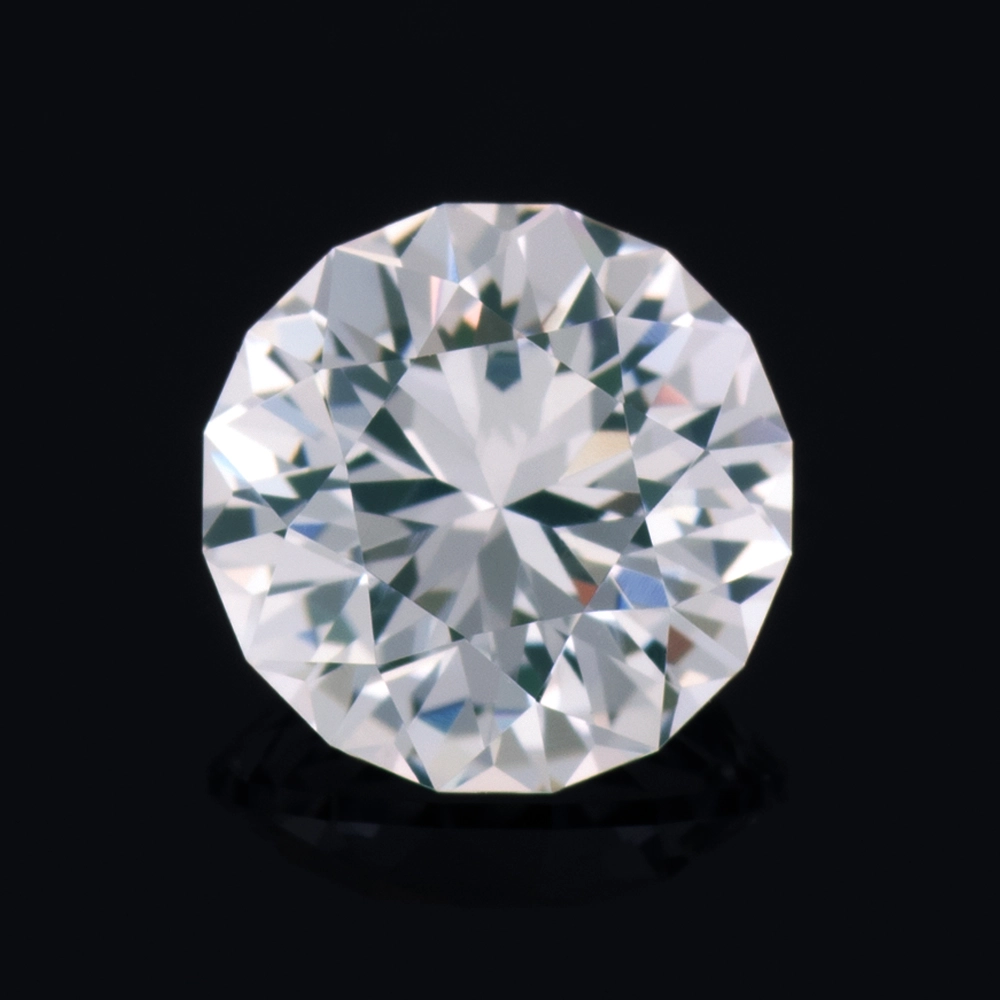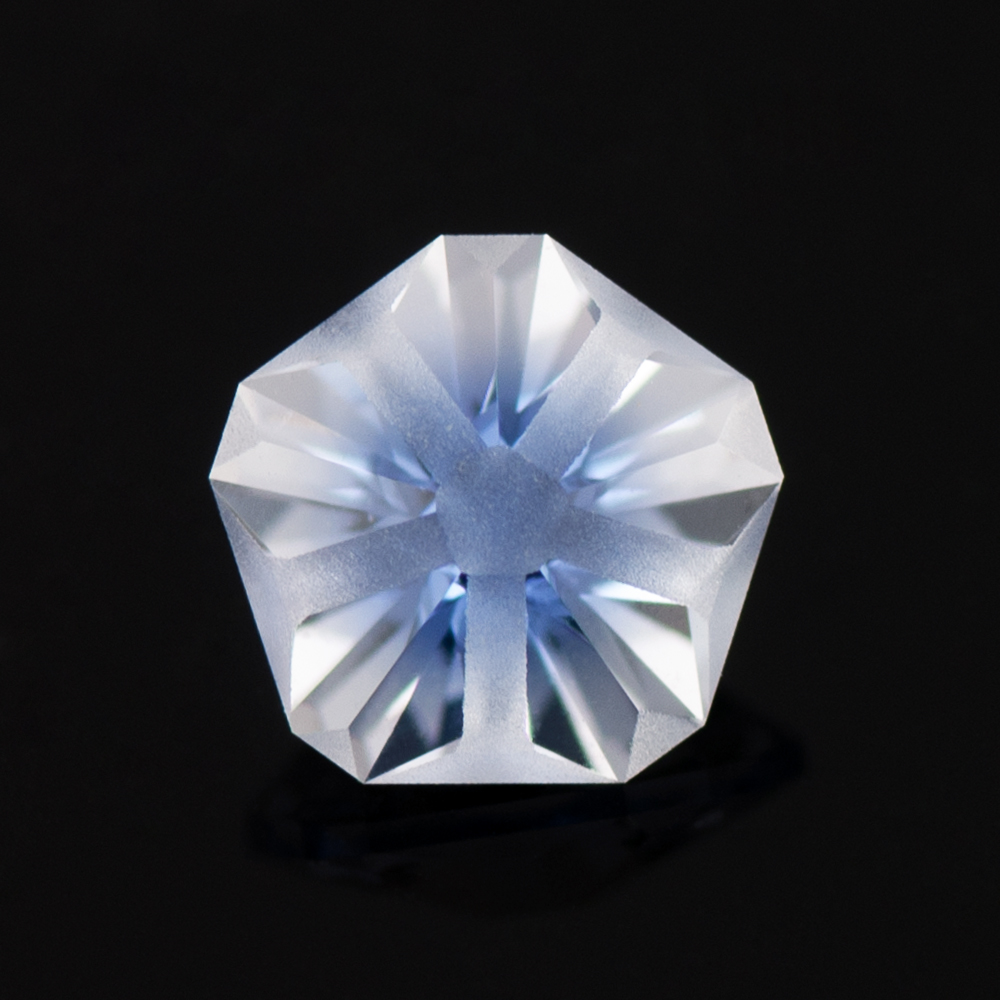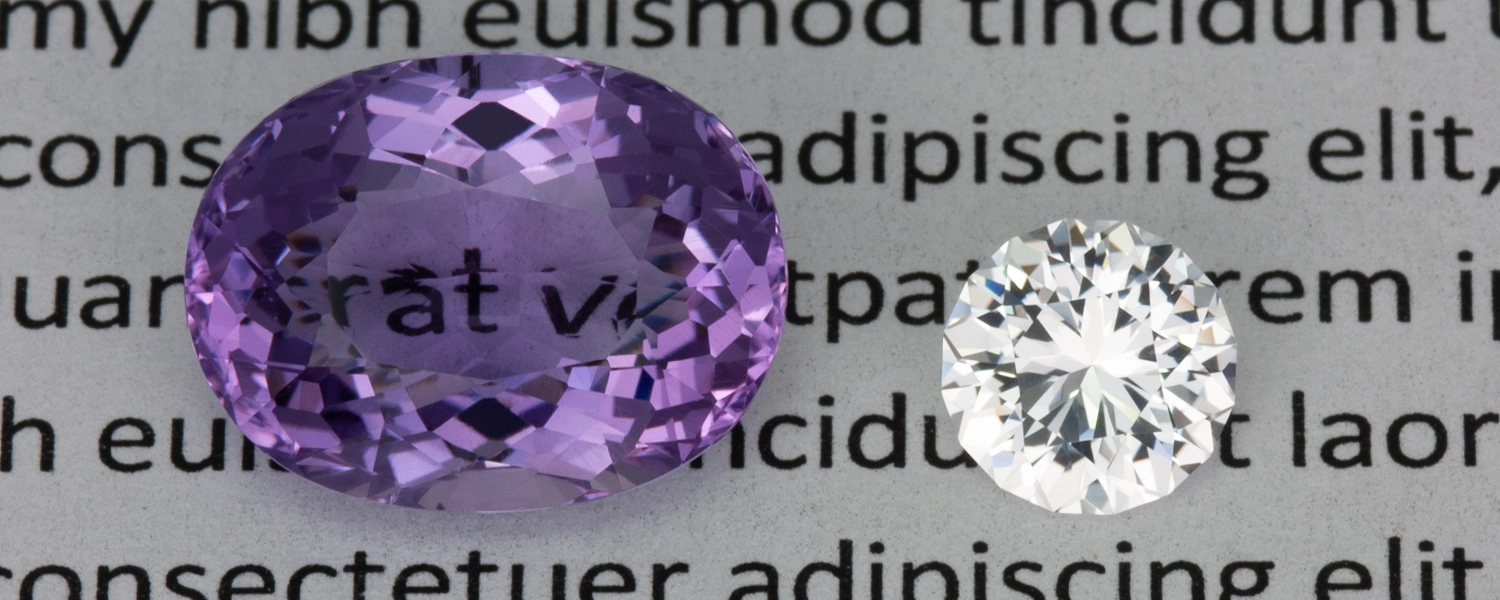
A 3.16 carat lab-created white sapphire in a radiant-style design, custom cut by us here in the studio.
What is a lab-created sapphire?
A lab-created sapphire is a type of synthetic sapphire, which means that it was man-made instead of being mined from the earth. The words “synthetic”, “lab-created”, and “lab-grown” all describe the same thing: a gemstone that was created instead of mined, that is physically and chemically identical to its natural counterpart. So, a lab-created white sapphire is a real sapphire, except it is man-made instead of mined from the earth.
Why choose a lab-created white sapphire over a natural white sapphire?
Some people are drawn to lab-created stones for their inclusion-free clarity and top-quality look and feel. But many people are attracted to them for other reasons. From an environmental standpoint, lab-grown white sapphires place less stress on natural resources and land:
- No digging of mines
- Less utilities and resource use
- Less pollutants and waste
They are also much easier to understand in terms of their place of origin. By comparison, natural white sapphires, like other naturally occurring gemstones, are difficult to trace from mine to consumer. Some people find this problematic because gemstones are often mined in countries that have very few environmental and labor laws.
Another excellent reason to choose a lab-grown white sapphire is the availability of rough material. Lab-grown rough is typically easier to acquire for most custom gemstone cutters, and since it comes in larger and more uniform pieces, a greater number of designs and sizes can be requested if working with the cutter on a custom stone.

One of our lab-created round brilliant white sapphires, in a custom-cut design. This stone measures 8.5mm and weighs 2.7 carats.

A lab-created white sapphire in a floral design that combines both polished and frosted facets. This particular stone has a tinge of blue in the center, which can appear to shoot outwards when rotating the stone from side to side.
Custom-cut vs. “commercial” cut lab-created white sapphires.
The term “cut” can sometimes be confusing because it often relates to the shape of a stone; for example, round cut, emerald cut, cushion cut, etc. But the “cut” we are referring to here relates to the actual cutting of the stone, which includes the angles that are used for the facets, the level of polish that has been achieved, and even the flatness of the facets. The quality of cut is a very important factor that relates to how light interacts with a gemstone.
This may seem relatively unimportant, with some people understandably thinking, “So what if the angles of the facets are a little off, and the polish isn’t that great?” Well, the level of polish does affect sharpness and reflectivity, but the angles of the facets are what truly make a gemstone shine.
If the angles aren’t chosen well, the light that enters a gemstone from the top will travel through its body and out the bottom. Any area of the gem that allows light rays to escape in such a way will appear lifeless and muted, and if bad enough, glass-like. This effect is known as windowing, and it can be seen in many commercially cut gemstones. Some windowing occurs even in well cut gemstones when the stone is tilted at an angle, but very little windowing should occur when looking directly down through the table or at a slight angle.

Left: a poorly cut heliodor that displays a very pronounced window, especially against a black background. Factory-cut.
Right: a well cut lab-created white sapphire with facet angles calibrated for low light leakage. Custom-cut by us.
The above image is an extreme example of a windowed stone, taken against a black background to make the window even more obvious. This poorly cut gemstone isn’t likely to turn up at your local jewelry store. However, you may find something like it online, with its picture taken against a background that helps to hide the window. The three images below show a factory-cut amethyst with a decent sized window, taken against different backgrounds to give you an idea of how the window changes depending on background type. The amethyst is shown beside a well-cut lab-created white sapphire for comparison.

Against an off-white or completely white background, this amethyst seems nice, although not quite as interesting in its center as at its edges. Does the center seem windowed to you?

When shown against a black background, the amethyst’s window becomes more apparent.

And when shown against a printed background, the center of the stone displays what the white background did a good job of hiding: a glass-like window that reveals the print beneath.
So-called factory-cut or commercial-cut gemstones are often on display at your local chain jewelry store. These stones are produced in large quantities, with the cutting houses walking a fine line between speed/efficiency, and a passable (or not so passable) cut quality. In these high volume situations, speed and efficiency become the most important factors, resulting in stones that lack vibrancy and life.
Because lab-created white sapphire rough is relatively cheap, commercial cutting houses become even more focused on speedy cutting when dealing with this material. If you decide to own a commercially cut lab-created white sapphire, it’s a good idea to choose your stone carefully. Unlike colored gemstones, in which poor cutting can be partially overcome by good color, white sapphire’s clear colorlessness means that any windowing appears very glass-like.
A lab-grown white sapphire that is custom-cut for precision and light performance is the alternative to a factory-cut. The upside to a custom-cut gemstone is an increase in brilliance and reflectivity. The downside is an increase in price, which results from the greater amount of time and effort needed to produce such a gem. Custom-cut gemstones are also more difficult to find, as they don’t fit into the world of mass-production that retail jewelers demand.
If you are interested in a lab-created white sapphire that is hand cut by us, you can check out our lab-created and natural gemstones shop page to see if we have any in stock and ready to ship, or use the contact button in the menu above to discuss your request.
What are the differences between a white sapphire, a diamond, and a moissanite?
The differences start with the fact that they are not the same mineral. This means that each of them has a unique way of interacting with light. It is this difference in light interaction that makes them appear and feel similar in some ways, while different in others. Since this article’s focus is on lab-created white sapphire, we will start there. Keep in mind that because lab-grown white sapphires are physically and chemically the real deal, most of what is said directly below applies to both natural and lab-grown white sapphires.

Left: VS1 clarity diamond with E color grading. Middle: fair quality natural white sapphire. Right: Charles & Colvard Colorless Forever One moissanite.
Lab-created white sapphire vs. diamond vs. moissanite.
When comparing lab-grown or natural white sapphire to diamond, the most important visual characteristic that plays in sapphire’s favor is color. Very few diamonds are close to or truly colorless; they usually have a yellowish or brownish tint, whereas lab-grown white sapphires (as well as many natural white sapphires) are almost entirely colorless. Often times this feature isn’t all that noticeable unless you have two stones side-by-side for comparison, so other optical characteristics tend to play a larger role.
These other characteristics primarily fall under the categories of brilliance and fire, which are the two most important features that distinguish diamond and moissanite from white sapphire.
- Brilliance: the term given for the amount of light that is reflected from the interior of a gem and returned to the viewer’s eye.
- Fire: the term used to describe the colorful flashes that can be seen in some gemstone types.
White sapphire has a good amount of brilliance, but not as much as either diamond or moissanite. This means that a well-cut white sapphire will appear bright, but the brightness takes on a slightly different character than either diamond or moissanite. I would describe the light as feeling colder or steely.
The most noticeable optical difference between these three gemstones lies in the amount of fire each displays, with white sapphire noticeably lagging behind the other two. If you are a person who adores the lively flashes of color that both diamond and moissanite provide, then a lab-created white sapphire may not be the best choice for you. On the other hand, a growing number of people are seeking out subtler gemstones with less sparkle and bling. If this is you, then a lab-created or natural white sapphire is an excellent choice, especially if you are particularly interested in a white gemstone.
The two videos below compare the three stones pictured above. They are a VS1 E color diamond, a Charles & Colvard Colorless Forever One moissanite, and a fair quality natural white sapphire. Do you know which one is which? Hint: each video has a different order.
The first video is taken under artificial kitchen lighting, while the second video is taken indoors on a winter’s day under diffuse lighting.
The gemstones in the first video are in the order of: moissanite, white sapphire, diamond. As you can see in the first video where mutli-point artificial lighting is used, the moissanite really has a lot of fire. The diamond on the far right in this video displayed better fire in person, which wasn’t picked up quite as well in the video. However, the moissanite still had more fire. The sapphire has very little to no fire.
The gemstones in the second video are in the order of: white sapphire, diamond, moissanite. The second video is taken under diffuse daylight, which is the type of lighting that displays brilliance more than fire. The differences in this video aren’t as apparent, with all three stones displaying a good amount of brilliance.
While we’re on the topic of optical properties, this is a good place to mention that lab-grown white sapphires tend to need more cleaning than either diamond or moissanite. This has to do with technical aspects in the way that light interacts with the stone, so just keep in mind that jewelry set with a lab-created white sapphire will need to be cleaned more frequently.
Ethical considerations.
Another key difference worth considering between these three gemstones has to do with their place of origin. Like lab-created white sapphire, moissanite is man-made, whereas natural diamonds are mind from the earth. Unfortunately, there are still social and environmental issues that the diamond trade hasn’t been able to resolve. Some people prefer to avoid these issues by purchasing a piece of jewelry with a lab-grown stone. If ethical considerations are important to you, then lab-created diamond, moissanite, and lab-created white sapphire are all good alternatives.
Cost.
And finally, we come to price. One of the main downsides to a decent quality diamond is the amount you have to pay, especially for stones that are in the 1 plus carat size range. Diamonds that are naturally formed in the earth are quite costly. Diamonds that are made in a lab are still quite expensive, but not as expensive as naturally occurring diamonds.
Both lab-created white sapphire and moissanite are significantly less costly than diamonds. The price can vary widely depending on who cut the gemstone (custom-cut vs. factory-cut), and in some cases, the quality of the stone (moissanite can be found in varying qualities and colors).
Other things to consider:
Sapphire ranks a 9 on the Mohs scale of hardness. Aside from diamond and moissanite, no other gemstone used in jewelry is as hard as sapphire. This high degree of hardness combined with good stability (relatively insensitive to heat, light, and chemicals) makes a lab-grown sapphire one of the most durable gemstones, which is a key quality in making it a suitable alternative to both diamond and moissanite.

